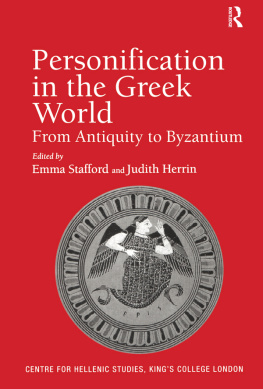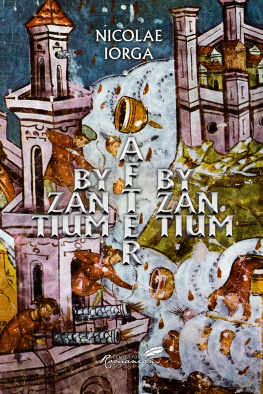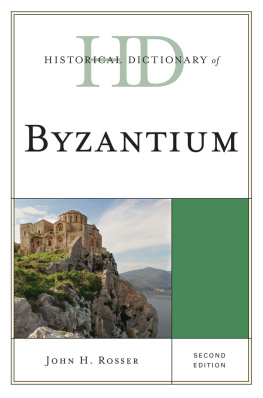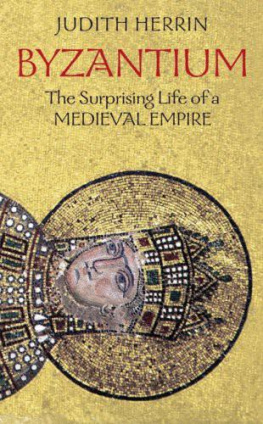List of Illustrations
Photographic acknowledgements are given in parentheses.
Mount Athos, Chalkidike (copyright Kallirroe Linardou)
Mount Sinai, Egypt (copyright Judith Herrin)
Constantinople, land walls (copyright ArtServe, reproduced by kind permission of Michael Greenhalgh)
Thessalonike, walls of the citadel (copyright Judith Herrin)
Aqueduct of Valens, Constantinople (copyright Judith Herrin)
Obelisk of Theodosius I (copyright Judith Herrin)
Silk roundel (copyright Dumbarton Oaks, Byzantine Collection, Washington DC)
Lead seal of kommerkiarioi (copyright Dumbarton Oaks, Byzantine Collection, Washington DC)
Pilgrim flask of St Menas (copyright The Trustees of the British Museum)
Frontispiece from the Bible of Leo (copyright Biblioteca Apostolica Vaticana)
Gold coins, Constantinople (copyright The Henry Barber Coin Collection, University of Birmingham)
Karanlik Kilisse, twelfth century, exterior (copyright Dick Osseman)
Karanlik Kilisse, interior fresco with fork (copyright Dick Osseman)
Ivory plaque of Christ, tenth century, Muse du Cluny, Paris (copyright Bridgeman Art Library)
Miniatures from the Khludov Psalter, ninth century (copyright M. V. Shchepkina, Miniatiury Khludovskoi Psaltyri (Moscow 1977))
Hagia Sophia from the sea (copyright Dick Osseman)
Mosaic of Zoe and Constantine IX flanking Christ, Hagia Sophia (copyright Dumbarton Oaks, Image Collections & Fieldwork Archives, Washington DC)
Hagia Sophia, interior from the western gallery (copyright Dumbarton Oaks, Image Collections & Fieldwork Archives, Washington DC)
Mosaic panel of Empress Theodora, San Vitale, Ravenna (copyright Bridgeman Art Library)
Mosaic panel of Emperor Justinian, San Vitale, Ravenna (copyright Bridgeman Art Library)
Icon of Christ, St Catherines, Mount Sinai (copyright the Holy Monastery of St Catherine, Mount Sinai, reproduced by kind permission of the monastery)
Gold coins of Constantine I and Basil II (copyright The Henry Barber Coin Collection, University of Birmingham)
Chalice of Romanos II, Treasury of San Marco, Venice (copyright Bridgeman Art Library)
Earring, sixth or seventh century, Benaki Museum (copyright Benaki Museum, Athens)
Greek fire, from John Skylitzes Chronicle (copyright Biblioteca Nacional Madrid, reproduced by kind permission of Miletos Press Archive, Athens)
Mosaic of Theodore Metochites, Chora monastery, Constantinople (copyright Dumbarton Oaks, Image Collections & Fieldwork Archives, Washington DC)
The Triumph of Orthodoxy, c. 1400, icon (copyright The Trustees of the British Museum)
Frontispiece from the Psalter of Basil II, c. 1000 (copyright Biblioteca Nazionale Marciana, Venice)
Basilica of San Marco, west front (copyright Bridgeman Art Library)
Two of the four classical bronze horses erected on the west front after 1204 (copyright Courtauld Institute, London)
Monastery of Hosios Loukas, Steiris, central Greece (copyright Judith Herrin)
Biblioteca Nacional Madrid, reproduced by kind permission of Miletos Press Archives, Athens)
Chora monastery, Constantinople (copyright Courtauld Institute, London)
Monastery of the Mother of God, Daphni, central Greece (copyright Judith Herrin)
Arta, church of the Paregoretissa, exterior (copyright Lioba Theis)
Church of the Paregoretissa, interior (copyright Lioba Theis)
Mistras, the citadel (copyright Judith Herrin)
Book of Job copied by Manuel Tzykandeles, probably in Mistras c. 1362 (Paris Bibliothque Nationale; copyright Bridgeman Art Library)
John VI Kantakouzenos presiding over the Council of 1351, c. 137075 (Paris Bibliothque Nationale; copyright Bridgeman Art Library)
Manuel II Palaiologos and his family, manuscript of Pseudo-Dionysios (Paris, Muse du Louvre; copyright Bridgeman Art Library)
Dioscorides, De materia medica, Making Lead, from an Arab translation of 1224, copied by Abd Allah ibn al-Fadl (Paris, Muse du Louvre; copyright Bridgeman Art Library)
p. 337 Sundial flanked by peacocks, Skripou, central Greece, 8734 (copyright Judith Herrin)
List of Maps
Introduction:
A Different History of Byzantium
One afternoon in 2002, two workmen knocked on my office door in Kings College, London. They were doing repairs to the old buildings and had often passed my door with its notice: Professor of Byzantine History. Together they decided to stop by and ask me, What is Byzantine history? They thought that it had something to do with Turkey.
And so I found myself trying to explain briefly what Byzantine history is to two serious builders in hard hats and heavy boots. Many years of teaching had not prepared me for this. I tried to sum up a lifetime of study in a ten-minute visit. They thanked me warmly, said how curious it was, this Byzantium, and asked why didnt I write about it for them? For someone dedicated to publishing on Byzantium I felt like objecting, but of course I knew what they meant. Endless books are written on Byzantine history too many to count and most too long to read. Often they describe the succession of 90 emperors, and about 125 patriarchs of Constantinople, and innumerable battles, in predictable categories of political, military and religious activity, relentlessly across eleven hundred years. Few are attractive enough to engage the interest of construction workers, or indeed non-specialists of virtually any other kind. So I began to compose an answer to the question: What is Byzantine history?
Immediately I got into difficulties I made too many assumptions, couldnt resist the abstruse anecdote. But I had always prided myself on being able to make Byzantine history interesting to audiences unfamiliar with it. As I searched for a method, I knew very well that in its long millennium Byzantium had enough colourful, shocking and tragic aspects to attract those who were seeking the sensational. But this reduced its history to dramatic episodes without depth, flattening the whole experience. Byzantium means more than wealth, mastery of the sea and the exercise of imperial power. I wanted them, and you the reader, to sense why Byzantium is also hard to grasp, difficult to place and can be obscure. This difficulty is compounded by contemporary newspapers use of Byzantine as a term of insult, for example in phrases like tax regulations of positively Byzantine complexity (a recent description of EU negotiations).
Byzantium conjures up an image of opaque duplicity: plots, assassinations and physical mutilation, coupled with excessive wealth, glittering gold and jewels. During the Middle Ages, however, the Byzantines had no monopoly on complexity, treachery, hypocrisy, obscurity or riches. They produced a large number of intelligent leaders, brilliant military generals and innovative theologians, who are much maligned and libelled by such Byzantine stereotypes. They never developed an Inquisition and generally avoided burning people at the stake. But there is a mystery associated with this lost world, which is hard to define, partly because it does not have a modern heir. It remains hidden behind the glories of its medieval art: the gold, mosaics, silks and imperial palaces.
To explain my appreciation of Byzantium, in this book I aim to set out its most significant high points as clearly and compellingly as I can; to reveal the structures and mentalities which sustained it. In this way I want to keep you interested to the end, so that you feel you get to know a new civilization. Crucially, I want you to understand how the modern western world, which developed from Europe, could not have existed had it not been shielded and inspired by what happened further to the east in Byzantium. The Muslim world is also an important element of this history, as is the lovehate relationship between Christendom and Islam.








